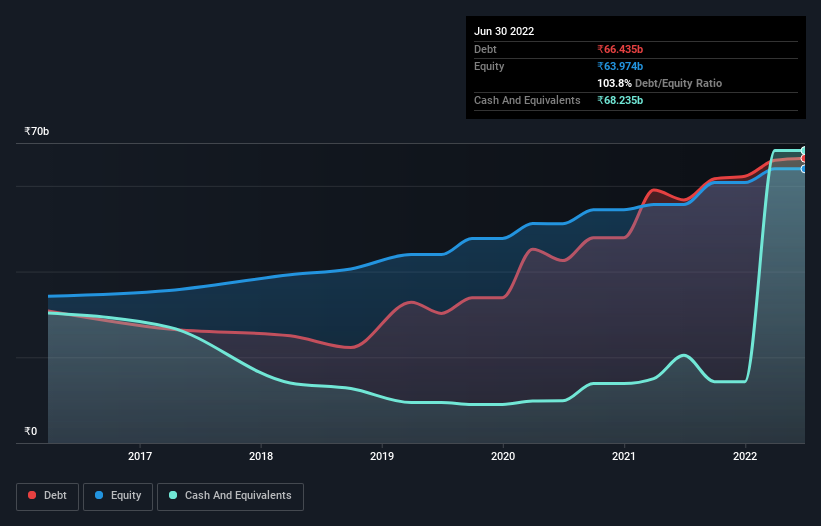
Howard Marks put it nicely when he said that, rather than worrying about share price volatility, 'The possibility of permanent loss is the risk I worry about... and every practical investor I know worries about.' So it seems the smart money knows that debt - which is usually involved in bankruptcies - is a very important factor, when you assess how risky a company is. We can see that Rail Vikas Nigam Limited (NSE:RVNL) does use debt in its business. But the real question is whether this debt is making the company risky.
When Is Debt Dangerous?
Generally speaking, debt only becomes a real problem when a company can't easily pay it off, either by raising capital or with its own cash flow. Ultimately, if the company can't fulfill its legal obligations to repay debt, shareholders could walk away with nothing. However, a more frequent (but still costly) occurrence is where a company must issue shares at bargain-basement prices, permanently diluting shareholders, just to shore up its balance sheet. Of course, plenty of companies use debt to fund growth, without any negative consequences. The first thing to do when considering how much debt a business uses is to look at its cash and debt together.
See our latest analysis for Rail Vikas Nigam
What Is Rail Vikas Nigam's Net Debt?
As you can see below, at the end of March 2022, Rail Vikas Nigam had ₹66.4b of debt, up from ₹56.7b a year ago. Click the image for more detail. But on the other hand it also has ₹68.2b in cash, leading to a ₹1.80b net cash position.

A Look At Rail Vikas Nigam's Liabilities
The latest balance sheet data shows that Rail Vikas Nigam had liabilities of ₹68.5b due within a year, and liabilities of ₹66.4b falling due after that. On the other hand, it had cash of ₹68.2b and ₹21.5b worth of receivables due within a year. So its liabilities outweigh the sum of its cash and (near-term) receivables by ₹45.1b.
This deficit is considerable relative to its market capitalization of ₹68.5b, so it does suggest shareholders should keep an eye on Rail Vikas Nigam's use of debt. Should its lenders demand that it shore up the balance sheet, shareholders would likely face severe dilution. While it does have liabilities worth noting, Rail Vikas Nigam also has more cash than debt, so we're pretty confident it can manage its debt safely.
We note that Rail Vikas Nigam grew its EBIT by 28% in the last year, and that should make it easier to pay down debt, going forward. The balance sheet is clearly the area to focus on when you are analysing debt. But it is future earnings, more than anything, that will determine Rail Vikas Nigam's ability to maintain a healthy balance sheet going forward. So if you want to see what the professionals think, you might find this free report on analyst profit forecasts to be interesting.
Finally, a business needs free cash flow to pay off debt; accounting profits just don't cut it. Rail Vikas Nigam may have net cash on the balance sheet, but it is still interesting to look at how well the business converts its earnings before interest and tax (EBIT) to free cash flow, because that will influence both its need for, and its capacity to manage debt. Over the last three years, Rail Vikas Nigam actually produced more free cash flow than EBIT. There's nothing better than incoming cash when it comes to staying in your lenders' good graces.
Summing Up
Although Rail Vikas Nigam's balance sheet isn't particularly strong, due to the total liabilities, it is clearly positive to see that it has net cash of ₹1.80b. The cherry on top was that in converted 139% of that EBIT to free cash flow, bringing in ₹47b. So we don't have any problem with Rail Vikas Nigam's use of debt. When analysing debt levels, the balance sheet is the obvious place to start. But ultimately, every company can contain risks that exist outside of the balance sheet. To that end, you should be aware of the 1 warning sign we've spotted with Rail Vikas Nigam .
Of course, if you're the type of investor who prefers buying stocks without the burden of debt, then don't hesitate to discover our exclusive list of net cash growth stocks, today.
New: AI Stock Screener & Alerts
Our new AI Stock Screener scans the market every day to uncover opportunities.
• Dividend Powerhouses (3%+ Yield)
• Undervalued Small Caps with Insider Buying
• High growth Tech and AI Companies
Or build your own from over 50 metrics.
Have feedback on this article? Concerned about the content? Get in touch with us directly. Alternatively, email editorial-team (at) simplywallst.com.
This article by Simply Wall St is general in nature. We provide commentary based on historical data and analyst forecasts only using an unbiased methodology and our articles are not intended to be financial advice. It does not constitute a recommendation to buy or sell any stock, and does not take account of your objectives, or your financial situation. We aim to bring you long-term focused analysis driven by fundamental data. Note that our analysis may not factor in the latest price-sensitive company announcements or qualitative material. Simply Wall St has no position in any stocks mentioned.
About NSEI:RVNL
Rail Vikas Nigam
Engages in the construction of rail infrastructure projects in India.
Excellent balance sheet second-rate dividend payer.


